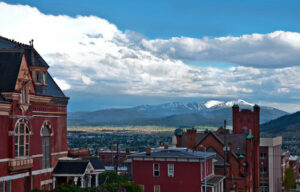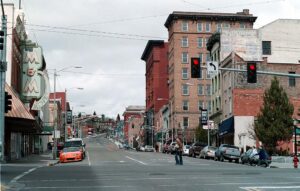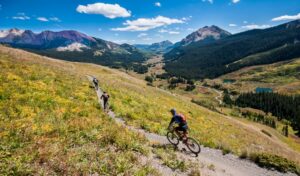In 2017, as part of the Tax Cuts and Jobs Act passed by Congress, a new economic development program called Opportunity Zones was created. Designed to encourage long-term private investments in areas with lower-income communities, these zones provide a federal tax incentive for those who invest in “opportunity funds.”
In 2018, Butte’s census tract one – which covers Uptown Butte – was selected by the Governor’s office to be one of 24 Opportunity Zones in Montana. We spoke with Brianne Downey, Financial and Project Manager for Butte’s Urban Revitalization Agency, to learn more about the benefits of operating a business within an Opportunity Zone.
Overview of Opportunity Zones
Opportunity Zones allow investors that have a capital gains liability to take advantage of a tax incentive by investing in a Qualified Opportunity Zone Fund (QOF). When they place these gains into the Opportunity Zone, they can be eligible for preferential tax treatment, such as elimination of the tax on the gain. The Urban Revitalization Agency, an organization dedicated to promoting the redevelopment and stimulation of investment within the central business district and surrounding neighborhoods in Butte, helps support this program.
According to Downey, there are only about 8,700 designated Opportunity Zones in the nation, putting more of a national spotlight on these areas that historically are economically distressed. By incentivizing investors to redevelop these areas, the intentis to spur redevelopment in these economically distressed areas and see growth that benefits both the investor and community.
Unique Benefits of Butte’s Opportunity Zone
Since Opportunity Zones are formed based on census tracts, Butte’s zone is on the larger size and covers more land than census tracts elsewhere. An Opportunity Zone on the east coast may only cover one city block, but in Butte, the zone encompasses all of the Butte Hill, covering about 1.7 square miles.

According to Downey, the benefits investors can see from acquiring property within an Opportunity Zone include the following: a deferral of capital gains taxes, a reduction of capital gains tax and elimination of taxes on future gains. Downey also noted how unique Butte’s Opportunity Zone is by highlighting how this zone offers additional benefits to investors with the ability to pair additional incentives the Opportunity Zone incentive. Examples of these incentives include Historic Tax Credits, Tax Increment Financing and New Market Tax Credits. Referred to as a “capital stack”, the ability to pair these federal, state, and local programs make for an attractive opportunity for investors.
Opportunity Zone Status Since Its Designation
Downey started with the Urban Revitalization Agency in January 2018, just a few months prior to when the Opportunity Zone was designated to Butte. Since April 2018, Downey has seen quite an increase in interest in the zone. On a daily basis, she fields many phone calls from individuals inquiring about the area that continues to gain national recognition thanks to its unique additional perks that set it apart from other zones. Downey reports that there are currently two projects in progress that selected Uptown Butte because of the zone designation. With the addition of these projects, Butte could see quite an impact on its economy that will benefit the community.
Taking the Right Steps to Operating on Opportunity Zone

The process of selecting, planning, and executing a new site for business operations can be complex. Investors will need to place their capital gains into a QOF which they will invest in the Qualified Opportunity Zone Property. QOFs can be created by any tax-paying individual or entity through self-certification. With a project this complex, Downey recommends that investors with capital gains work with an attorney, financial advisor, or a CPA when considering an Opportunity Zone.
Why Butte?

There are many reasons to choose Butte. In addition to the tax incentives, land, and business benefits, Butte itself is a thriving and supportive community.
When asked why Butte, Downey had this to say: “What’s not to love about Butte?!? We have amazing summer festivals, great local restaurants, a wonderful school system, opportunities for recreation, fascinating history and architecture, but most of all the people!”
Convinced? Follow these links to learn more about URA, see how MCBDP takes advantage of these incentives and explore more reasons why Butte is a great place to live and work.
Read The Full Interview Here
1. Tell us a little bit about the Urban Revitalization Agency.
The Urban Revitalization Agency is designed to promote the redevelopment and stimulation of investment within the central business district and surrounding neighborhoods. We do this utilizing tax increment financing. We have loan and grant programs and invest in other public and private improvements such as vaulted sidewalks repairs. We have a 5-member board that meets monthly to approve projects. The current district was created in 2014.
2. How did you come to work for URA?
I started with the URA in January of 2018. The prior financial consultant retired after 35+ years of working with Butte-Silver Bow. I have a background in tax, auditing local governments, and hospitality (strange, right?!?) which has proven to be a unique set of skills for this position.
3. When did the Opportunity Zones begin in Butte?
Butte’s census tract one was designated as 1 of Montana’s 25 Opportunity Zones in April of 2018. The local economic development team sent this tract to the Governor’s Office for this designation. The Governor then selected 24 other census tracts throughout the state and submitted those to the Department of Treasury as a part of the Tax Cuts and Jobs Act of 2017 passed by Congress.
4. As the go-to person for the Opportunity Zone covering Butte Hill, what does a typical day of work look like for you?
Regarding Opportunity Zones, my typical day is spent answering questions and researching. This legislation/tool is new and still evolving. People may understand bits and pieces and I can help fill the voids. I read as much as I can find on what other communities have done and how it is or isn’t working. We believe that it is the local government’s role to educate, promote our OZ, and provide support to those pursuing OZ financing.
5. How does working in an Opportunity Zone benefit the businesses that operate within the boundaries?
Investors that acquire property within the Opportunity Zone, with money they received from capital gains after December 31, 2017, can see (1) a deferral of capital gains taxes (2) reduction of capital gains tax and/or (3) elimination of taxes on future gains. There are different timeframes for each of these tax benefits. Our area is unique in that we can pair additional incentives within the OZ. These programs include other federal, state and local programs. This is often referred to as “capital stack”. The availability of other programs strengthens and entices investors to our OZ. Existing businesses will see the benefit of the redevelopment of neighboring buildings or vacant lots and a stronger economy. I think of the adage, a rising tide lifts all boats.
6. During your time with URA, how would you describe Opportunity Zones’ effects on Butte’s economy?
Since being designated as an Opportunity Zone, I have fielded more phone calls from individuals interested in our area. There are only 8,700 Opportunity Zones nationally, some being the size of a city block. This designation, as well as the size of the area, gives us national recognition. The Economic Development team (BSB, BLDC/Headwaters, Chamber of Commerce/CVB) has done a great job promoting our area by attending conferences, creating a website and community profile prospectus.
We have two current projects that chose to locate in Uptown Butte specifically because of our Opportunity Zone designation. These projects could lead to quite the ripple effect. How difficult is the process of setting up a business in an Opportunity Zone?
7. Is there an approval process for selecting a site within an Opportunity Zone?
This is a complex question to answer so I’m going to scale it back considerably. Investors must place their capital gains in a Qualified Opportunity Fund (QOF) and that fund then invests in the Qualified Opportunity Zone Property. QOFs can be created by any taxpaying individual or entity through a self-certification process. I suggest that individuals with gains work with an attorney, financial advisor or CPA when asked this question.
8. Are you from Butte originally? If not, what brought you to Butte/Montana?
Even though I am not from Butte, I have deep roots. My dad is 1 of 12 children that grew up in Centervillle on the Butte Hill. I moved around the state quite a bit growing up, landing in Bozeman, Libby, Anaconda, but home base was always my grandparent’s (maternal) ranch in Big Timber. Once I graduated college (MSU), I chose to come to Butte because my parents live here. Family has always been important to me and I wanted to raise my children with that same influence.
9. What is your favorite part about living in Butte?
What’s not to love about Butte?!? We have amazing summer festivals, great local restaurants, a wonderful school system, opportunities for recreation, fascinating history and architecture, but most of all the people!




